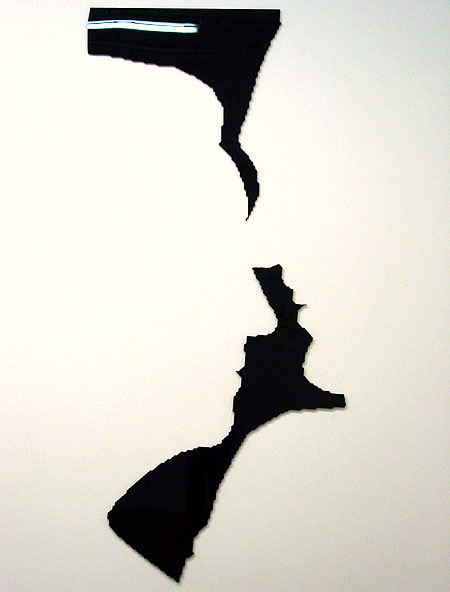
His current show at Friedrich Petzel channels Metro Pictures from 20 years ago: picture + hidden agenda + "luxury" commodity. One can discern that the slabs of shiny plasticized woodgrain define silhouettes and what they're of (portrait profiles; hands holding cigarettes, microphones, and keys) but you have to go to the press release to learn they're jpegs--or "jpegs" as that handout cautiously air-quotes them--originating in google searches of words such as eating, touching, mother, etc. Yet a boring picture of two people kissing is still boring, even when made with laser-cut Quartered Honduran Mahogany or Burled Carpathian Elm.
The work recalls Sherrie Levine's silhouettes of U.S. presidents framing stock images of women and Ronald Jones's, later, expensively fabricated objects disguising political content: Brancusi-like bronze sculptures revealed to be AIDS cells or Alexander Libermanesque wall reliefs based on designs for negotiating tables proposed for the Vietnam War peace talks. Price's work is neither as politically charged nor as exquisitely crafted as Jones'. One assumes he is being stylishly politically incorrect referencing what sound like old growth hardwoods used in the fabrication of these planks and placards. They are just a plastic coated veneer but it's still wood.
Contentwise we have two levels of making a readable, everyday image esoteric: isolating the negative space of the jpeg image and then turning that space into an object. Bruce Nauman, Rachel Whiteread, and many others have done this. With Nauman, the viewer could puzzle out "Oh that's the underside of a chair" and "get it" but here you need a gallerist/initiate to tell you the secret back story of the work's Internet origins. This revelation can only disappoint.
For theoretical undergirding Sherrie Levine had Douglas Crimp and Jones had a PhD. Price follows the latter in self-explication, writing essays to accompany his shows and music releases. In the earlier "Dispersion" and "Vas Ist Los" individual paragraphs shine but the overall points aren't clear; Price is more poet than thinker. The Petzel show comes with a book called How To Disappear in America, a sort of latter day Steal This Book about the perils of dropping out in a surveillance society. It is issued by a fictional publisher (theleopardpress.com) and has nothing to do with the show.
Time Out, reviewing an earlier Price exhibit, quoted Marcel Broodthaers that art occurs "in the field of distribution," implying that's what Price is doing. Yet if "Dispersion," the essay, has a point it's that the distribution must occur within the art system because artists' attempts to market directly to the public, or to the wrong public (i.e., music consumers) fail for lack of context, as in Duchamp's effort to sell his rotoreliefs at a toy inventors' fair. Thus, Price's "dispersion" is through limited edition books at Printed Matter, pdf files on ubuweb, and sales to elite collectors at Petzel. The contradiction between the populist "dispersion" rhetoric and making broadly available commodities ("jpegs") limited for the gallery trade isn't a fatal flaw so much as tapping guilt-as-usual about participating in the system. Current curatorial practice demands that artists prove they're not making work for selfish reasons and are helping The People, man.
Update: Paddy Johnson notes the literal connection between Price's book and the exhibit: one deals with disappearing people and the other disappearing subjects. Saying the book had "nothing to do with the show" meant in the sense of being its own Crimp- or Jones-like exegesis, but I should have made that clearer. Johnson's observation that the show "focuses on the invisibility of the artist’s hand, and the removal of the body while performing an action of any kind" is eloquent but perhaps too much so for Price's Photoshop-simple acts of deletion.
Update 2: minor editorial changes to post.
